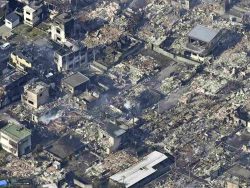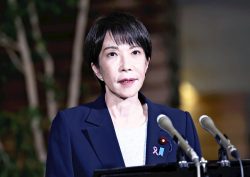Use of Alternative Landing Paths at Haneda Airport to be Postponed; January Collision Causes Concern Over Major Changes

An air traffic control tower is seen at Haneda Airport in January.
21:00 JST, December 23, 2024
The government has decided to postpone its decision over the introduction of temporary alternative landing paths for Haneda Airport, partly due to the aircraft collision that occurred at the airport in January, The Yomiuri Shimbun has learned.
The paths, which would lie over Tokyo Bay’s coast, were being considered as a way to mitigate the noise issues of the new flight paths over central Tokyo introduced in March 2020.
Although the Land, Infrastructure, Transport and Tourism Ministry had already examined the alternative route, and technically feasible flight operations had been established, it decided to postpone its introduction. In the wake of the aircraft collision, the ministry decided that any major change or further complication to air traffic control operations should remain under careful consideration for the time being, according to the government sources.
The ministry will formally decide to postpone the conclusion on the alternative paths at a meeting of experts in the coming days.

The meetings consist of eight experts from the relevant fields, including former pilots, and was established by then transport minister Kazuyoshi Akaba in June 2020 in response to noise complaints from residents and local governments located directly under the new flight paths. The experts have been discussing changing the flight paths at the meetings from technological and operational points of view.
During the process, the ministry eyed routes over the sea, which would significantly reduce the impact of the noise. It examined the feasibility of several flight operation systems for landing.
After the examination, the system called “RNP-AR,” or Required Navigation Performance — Authorization Required, was considered “technically suitable and adoptable,” from a safety standpoint. RNP-AR enables aircraft to conduct high-precision curved flights on autopilot using GPS signals.
However, the Boeing 767 model, a mid-sized passenger aircraft used by many of Japan’s major airlines, is not compatible with the RNP-AR system, and even some compatible aircraft require initial and periodic training for pilots. This would create a major burden for airline companies.
Furthermore, since the January collision involving a JAL and a Japan Coast Guard aircraft at Haneda, more attention is being placed on the work burden of the air traffic controllers who monitor its runways. Considering that major operational changes and further procedural complications could increase the risk of human error, the government concluded it was too early to introduce the alternative routes.
The 2020 flight routes fly over central Tokyo, including over Shinjuku, Shibuya and Shinagawa. They were introduced to boost the international competitiveness of Haneda airport and also to reduce the disproportionate burden of noise pollution on Chiba Prefecture.
"Society" POPULAR ARTICLE
-

M7.5 Earthquake Hits Northern Japan; Tsunami Waves Observed in Hokkaido, Aomori and Iwate Prefectures
-

Fire Damages 170 Buildings in Oita, Western Japan
-

M5.7 Earthquake Hits Japan’s Kumamoto Pref., Measuring Upper 5 Intensity, No Tsunami Expected
-

Beloved Cat Stationmaster Nitama in Wakayama Pref. Passes Away at 15
-

No Easy Fix for Tokyo’s Soaring Real Estate Prices
JN ACCESS RANKING
-

Japan’s Hopes for Seafood Exports Shot Down in China Spat
-

Essential Services Shortage to Hit Japan’s GDP By Up to ¥76 Tril. By 2040
-

Japan to Charge Foreigners More for Residence Permits, Looking to Align with Western Countries
-

Japan GDP Down Annualized 1.8% in July-Sept.
-

Niigata Gov. to OK Restart of N-Plant; Kashiwazaki-Kariwa May Be Tepco’s 1st Restarted Plant Since 2011
























